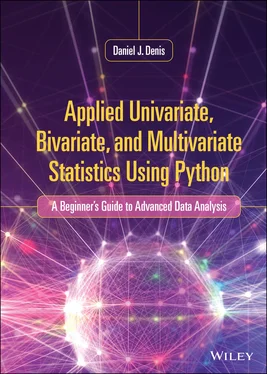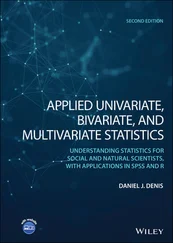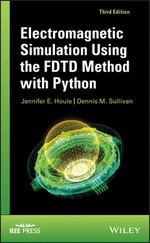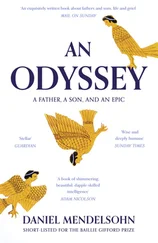It is hoped that you enjoy this book as a gentle introduction to the world of applied statistics using Python. Please feel free to contact me at daniel.denis@umontana.eduor email@datapsyc.comshould you have any comments or corrections. For data files and errata, please visit www.datapsyc.com.
Daniel J. Denis
March, 2021
1 A Brief Introduction and Overview of Applied Statistics
CHAPTER OBJECTIVES
How probability is the basis of statistical and scientific thinking.
Examples of statistical inference and thinking in the COVID-19 pandemic.
Overview of how null hypothesis significance testing (NHST) works.
The relationship between statistical inference and decision-making.
Error rates in statistical thinking and how to minimize them.
The difference between a point estimator and an interval estimator.
The difference between a continuous vs. discrete variable.
Appreciating a few of the more salient philosophical underpinnings of applied statistics and science.
Understanding scales of measurement, nominal, ordinal, interval, and ratio.
Data analysis, data science, and “big data” distinctions.
The goal of this first chapter is to provide a global overview of the logic behind statistical inference and how it is the basis for analyzing data and addressing scientific problems. Statistical inference, in one form or another, has existed at least going back to the Greeks, even if it was only relatively recently formalized into a complete system. What unifies virtually all of statistical inference is that of probability. Without probability, statistical inference could not exist, and thus much of modern day statistics would not exist either (Stigler, 1986).
When we speak of the probability of an event occurring, we are seeking to know the likelihoodof that event. Of course, that explanation is not useful, since all we have done is replace probability with the word likelihood. What we need is a more precise definition. Kolmogorov (1903–1987) established basic axioms of probabilityand was thus influential in the mathematics of modern-day probability theory. An axiomin mathematics is basically a statement that is assumed to be true without requiring any proof or justification. This is unlike a theoremin mathematics, which is only considered true if it can be rigorously justified, usually by other allied parallel mathematical results. Though the axioms help establish the mathematics of probability, they surprisingly do not help us define exactly what probability actually is. Some statisticians, scientists and philosophers hold that probability is a relative frequency, while others find it more useful to consider probability as a degree of belief. An example of a relative frequency would be flipping a coin 100 times and observing the number of heads that result. If that number is 40, then we might estimate the probability of heads on the coin to be 0.40, that is, 40/100. However, this number can also reflect our degree of belief in the probability of heads, by which we based our belief on a relative frequency. There are cases, however, in which relative frequencies are not so easily obtained or virtually impossible to estimate, such as the probability that COVID-19 will become a seasonal disease. Often, experts in the area have to provide good guesstimates based on prior knowledge and their clinical opinion. These probabilities are best considered subjective probabilitiesas they reflect a degree of belief or disbelief in a theory rather than a strict relative frequency. Historically, scholars who espouse that probability can be nothing more than a relative frequency are often called frequentists, while those who believe it is a degree of belief are usually called Bayesians, due to Bayesian statistics regularly employing subjective probabilities in its development and operations. A discussion of Bayesian statistics is well beyond the scope of this chapter and book. For an excellent introduction, as well as a general introduction to the rudiments of statistical theory, see Savage (1972).
When you think about it for a moment, virtually all things in the world are probabilistic. As a recent example, consider the COVID-19 pandemic of 2020. Since the start of the outbreak, questions involving probability were front and center in virtually all media discussions. That is, the undertones of probability, science, and statistical inference were virtually everywhere where discussions of the pandemic were to be had. Concepts of probability could not be avoided. The following are just a few of the questions asked during the pandemic:
What is the probability of contracting the virus, and does this probability vary as a function of factors such as pre-existing conditions or age? In this latter case, we might be interested in the conditional probability of contracting COVID-19 given a pre-existing condition or advanced age. For example, if someone suffers from heart disease, is that person at greatest risk of acquiring the infection? That is, what is the probability of COVID-19 infection being conditional on someone already suffering from heart disease or other ailments?
What proportion of the general population has the virus? Ideally, researchers wanted to know how many people world-wide had contracted the virus. This constituted a case of parameter estimation, where the parameter of interest was the proportion of cases world-wide having the virus. Since this number was unknown, it was typically estimated based on sample data by computing a statistic (i.e. in this case, a proportion) and using that number to infer the true population proportion. It is important to understand that the statistic in this case was a proportion, but it could have also been a different function of the data. For example, a percentage increase or decrease in COVID-19 cases was also a parameter of interest to be estimated via sample data across a particular period of time. In all such cases, we wish to estimate a parameter based on a statistic.
What proportion of those who contracted the virus will die of it? That is, what is the estimated total death count from the pandemic, from beginning to end? Statistics such as these involved projections of death counts over a specific period of time and relied on already established model curves from similar pandemics. Scientists who study infectious diseases have historically documented the likely (i.e. read: “probabilistic”) trajectories of death rates over a period of time, which incorporates estimates of how quickly and easily the virus spreads from one individual to the next. These estimates were all statistical in nature. Estimates often included confidence limits and bands around projected trajectories as a means of estimating the degree of uncertainty in the prediction. Hence, projected estimates were in the opinion of many media types “wrong,” but this was usually due to not understanding or appreciating the limits of uncertainty provided in the original estimates. Of course, uncertainty limits were sometimes quite wide, because predicting death rates was very difficult to begin with. When one models relatively wide margins of error, one is protected, in a sense, from getting the projection truly wrong. But of course, one needs to understand what these limits represent, otherwise they can be easily misunderstood. Were the point estimates wrong? Of course they were! We knew far before the data came in that the point projections would be off. Virtually all point predictions will always be wrong. The issue is whether the data fell in line with the prediction bands that were modeled (e.g. see Figure 1.1). If a modeler sets them too wide, then the model is essentially quite useless. For instance, had we said the projected number of deaths would be between 1,000 and 5,000,000 in the USA, that does not really tell us much more than we could have guessed by our own estimates not using data at all! Be wary of “sophisticated models” that tell you about the same thing (or even less!) than you could have guessed on your own (e.g. a weather model that predicts cold temperatures in Montana in December, how insightful!).
Читать дальше












